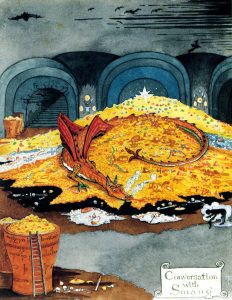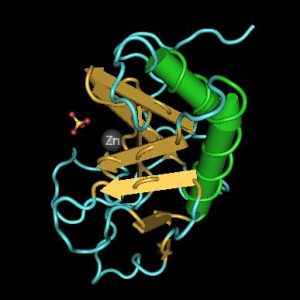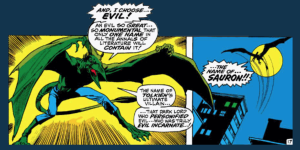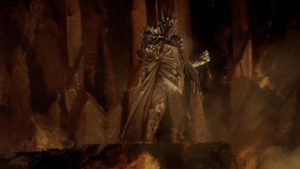Allow me a short digression into something nerdy. It’s niche and weird but I slipped in some science along the way. Whilst doing a bit of reading for another project the other day I stumbled across a curious link between two very different worlds; the science of Palaeontology, and the fictional antagonist of Middle-Earth. I subsequently went on to discover that link again, and then again. All of which led me to ask; why does Sauron keep popping up in palaeo?
For those unaware, Sauron is a character created by JRR Tolkien, he is in fact the eponymous Lord in the Lord of the Rings, and in all of the extensive writings of character lore for Sauron, not once is there any mention that he is a keen amateur palaeontologist. In fact, seeing as Arda (the Tolkien name for Earth) is written as only being a few tens of thousands of years old, it could be argued that palaeontology doesn’t even exist in Middle Earth. I suppose they don’t need dinosaurs seeing as they have actual dragons.

In our reality though, we have fossils going spare, and a seemingly endless supply of new species of extinct creatures being discovered, and our need to categorise everything into neat little orders means that these new discoveries need names. Usually the animals are named after some descriptive features of their anatomy (take our own Thecodontosaurus, which means ‘Socket-toothed Lizard’ for example). However, sometimes scientists like to get a bit more fantastical and inventive with names.
This was the case when a peculiar fossil resurfaced for description in 2012. The specimen was a single bone from a skull of what seemed to be a large theropod dinosaur. Specifically, this bone was the frontal, which is located just above the eye socket.

It may not seem like much (because it isn’t really) but palaeontology is a science that regularly has little to go on but the most fragmentary evidence, and in this case the researchers deemed that there were enough unique features to declare the fragment as coming from a hitherto unknown species. An ancient terror, having lost most of its physical form and now known only from a piece of eye socket, it was dubbed Sauroniops, literally meaning ‘The Eye of Sauron’. The name does have a nice ring to it.
The single Sauroniops bone originated from the famed Kem Kem beds of Morocco. This formation is well known for its assemblage of Cretaceous fossils, including fish, crocodiles, dinosaurs, and pterosaurs. The fossil the area is most famed for is undoubtedly Spinosaurus, the largest (and probably most controversial) theropod dinosaur ever found.
Sauroniops was a Carcharodontosaur, another group of large theropods, named for their shark-like teeth. Other members of this group have distinctive brow ridges, narrow snouted skulls, and sharp claws (which look to have been more effective than the reduced arms of T. rex).

Based on the size of the lone fossil, Sauroniops shows the over-engineered brow you’d expect from this dinosaur group. It also gives us an estimate in size of up to about 10m in length, though this is obviously largely speculation based on similar species.
Though not a Spinosaur, Sauroniops has still enjoyed its fair share of palaeo controversy. Being known from only a single bone will always mean doubts will be made about whether there is enough evidence to claim it as a unique species. The main arguments against it state that it is likely just a younger individual of Carcharodontosaurus, which is also found in the same location.
It is a reasonable argument, as ontogenetic variation (how animals appear different as they age) is easily overlooked in a science where we frequently have nothing to go on but skeletal fragments. It’s even fitting for Sauron, who too has a history of not being recognised as his true self (I’m on to you Annatar). Though a review of Kem Kem Carcharadontosaur material in 2022 retained Sauroniops’ position as a valid taxon, so it as a species remains safe for now at least.
Naming discoveries after pop culture figures is hardly rare, and it is something that our own palaeo group at Bristol is guilty of indulging in. In recent years our resident scientists have named an ancient lizard-like animal after a spell from Harry Potter (Clevosaurus sectumsempra), and a vicious bobbit worm after the bassist from the death metal band Cannibal Corpse (Websteroprion).

It’s not just palaeontology either, geneticists get in on this act too. In the scientific literature, researchers discussing the mysteries of developmental biology frequently refer to a gene-coded protein by its genuine official name; Sonic Hedgehog.

Sauroniops represents what I suppose you could call the most ‘official’ link between Tolkien’s Dark Lord of Mordor, and the science of palaeontology. But it is far from the only time these two seemingly disparate worlds have combined.
As far back as 1969, just fifteen years after the publishing of the Lord of the Rings, this union was first formed in the Marvel Comic Book universe. That’s right, palaeontology, Tolkien, and Marvel; we really are venturing into some kind of holy trinity of nerdom.
Allow me to introduce you to Dr Karl Lykos. Unlike other doctors we’ve mentioned in this blog in the past, Dr Lykos is not a palaeontologist, he is a hypnotherapist who, whilst still only a young boy, travelled to Tierra del Fuego, the archipelago at the southernmost tip of South America. It was here that Lykos was attacked by a living Pteranodon, which had travelled up from deep in the primal Savage Lands of Antarctica to turn him into a vampire.
In case that last sentence didn’t make it clear, Dr Karl Lykos a fictional resident of what comic book fans call Earth-616. That vampiric pterosaur bite transforms him into some human-pterosaur hybrid, leading to the inevitable turn to evil and embracing of a supervillain name; Sauron.

Canonically he chooses the name Sauron here specifically in honour of Tolkien’s creation, as a name fit for his new evil state. But any parallels to the actual character seem to begin and end there. As for the connections to actual palaeontology, they are just as tenuous.
The Pteranodon form Dr Lykos takes is supposedly part human, so I suppose you can forgive some of the inaccuracies, though I am still going to point them out. Starting with the fact that Pteranodons had specific musculature to allow them to fly effectively which, whilst strongly built, doesn’t really line up with the human arrangements. So you can probably write off any real Pteranodon having the spectacular washboard abs Sauron (the non-Tolkien one) regularly puts on display.

Likewise the wings of Pteranodon, as for all pterosaurs, are supported by a highly evolved and modified finger (the commonly used colloquial moniker of pterodactyl literally means ‘Wing Finger’). This meant that the totally free to move hands of Sauron (with opposable thumbs and all) wouldn’t have been a feature on the real thing.
Also Pteranodons didn’t have a mouthful of razor-sharp teeth; they had toothless beaks, which is a common adaptation of flying animals to help them kept their body weight down (see: all living birds). The fictional Sauron is regularly shown as having a long tail too, a feature which had been long since lost by Pteranodons and other large pterosaurs as they evolved.
So palaeontological accuracy may not be the strongpoint of this other fictional Sauron, but at least it did give us one of the greatest memes to have come out of the graphic novel world.

If you’re still following me down this obscure rabbit hole, allow me to set the scene for the third link I stumbled upon. It’s 1994, you’ve just finished re-watching your VHS copy of Jurassic Park now overdue from Blockbuster, BoyzIIMen is on the radio, and you’re confident that all dinosaurs had scales and you’d never be proven wrong on that fact.
To celebrate life being this good you’re going to take your change to the nearest Video Arcade to play your favourite new game, ‘Primal Rage’. This is a Mortal Kombat-esque fighting game where you take on the persona of what can loosely be described as prehistoric fauna. You reach the character select screen and pick your go-to MVP, his name, is Sauron.
Sauron is a yellow T. rex with purple stripes, marking the second time that Tyrannosaurus has been reconstructed with these two colours (though Sauron is a bit less kid-friendly than Barney – I’m not sure Sauron would sing in a circle with me at all). He stands upright, propped up by his tail, in a similar pose to how dinosaurs were reconstructed around 100 years ago when the first skeletal mounts were debuted (and kinda Barney again I guess). It’s a pose we now know to be horribly wrong, and a lot less horizontal than would be ideal.

Just like Tolkien’s non-dinosaur version, this Sauron is immortal to be untouched by the effects of passing years, though the cost of this is that he’s always hungry for humans, who view him as a god… and want to get eaten… Look, the plot of this game is a little odd. The continents are inexplicably rearranged to look like a fire-breathing dinosaur skull, scientific accuracy or sanity is not it’s strong point.
I could go into more details about how this video game character is similar to the literary Sauron and how it all connects to palaeontology, but I’ve think we’ve all reached our limit of patience with this niche deep dive of an article, and instead I’m going to cut it short with a fifteen-minute playthrough video I found on YouTube of someone completing the arcade version of the game as Sauron. I think we all knew the article was always going to end like this.
Rhys Charles is the Engagement Officer for the Earth Sciences department of the University of Bristol, and has headed the Bristol Dinosaur Project since 2016. (@tweetodontosaur)
Article edited by Ben Griffin.
References
Cau, A., Vecchia, F.M.D., & Fabbri, M. (2012) Evidence of a new carcharodontosaurid from the Upper Cretaceous of Morocco. Acta Palaeontologica Polonica. 57: 661 – 665
Paterna, A., & Cau, A. (2022) New giant theropod material from the Kem Kem Compound Assemblage (Morocco) with implications on the diversity of the mid-Cretaceous carcharodontosaurids from North Africa. Historical Biology. 1 – 9
Klein, C. et al. (2015) A distinctive Late Triassic microvertebrate fissure fauna and a new species of Clevosaurus (Lepidosauria: Rhynchocephalia) from Woodleaze Quarry, Gloucestershire, UK. Proceedings of the Geologists Association. 126: 402 – 416
Eriksson, M.E., Parry, L.A., & Rudkin, D.M. (2017) Earth’s oldest ‘Bobbit worm’ — gigantism in a Devonian eunicidan polychaete. Scientific Reports. 7: 43061

